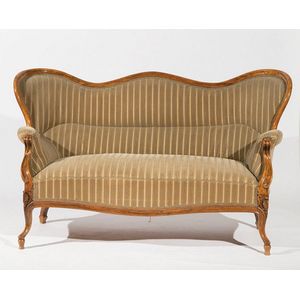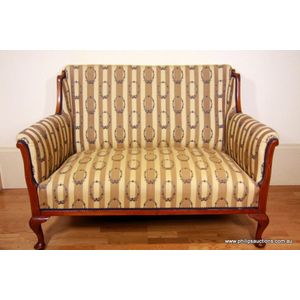Biedermeier Style Birch Sofa with Inlay and Damask Upholstery
You must be a subscriber, and be logged in to view price and dealer details.
Subscribe Now to view actual auction price for this item
When you subscribe, you have the option of setting the currency in which to display prices to $Au, $US, $NZ or Stg.
- Parquetry - Parquetry is inlay laid in geometric patterns, the contrast being achieved by the opposing angles of the grain and veneers. The herringbone pattern is the most commonly used in flooring, but this is almost never seen in furniture - the patterns used are more complex and unlike flooring, can include several different varieties of timber.
- Birch - Birch is a Northern Hemisphere hardwood, closely related to the beech/oak family, and was a timber popular with 18th century craftsmen. Because of the blonde-golden colour of the grain when polished and its close grain, as a veneer it is often used as a substitute for satinwood where cost savings are required. From the late 18th century cabinetmakers in Russia and Eastern Europe used it in the solid for chairs and other furniture.
Karelian birch is birch with a burr grain that resembles marble, from the Karelia region between Finland and Russia. Because only 30% to 40% of seeds result in trees with Karelian birch features, and the fact that it is very slow growing, the timber is very expensive. - Damask - Damask is a type of fabric that is characterized by its glossy finish, smooth texture, and intricate designs. The fabric is typically made from a combination of silk and other natural fibers, such as cotton or linen, and is often used to make clothing, upholstery, and other decorative items.
The origins of damask fabric can be traced back to ancient Rome and the Byzantine Empire, where it was used to make clothing and other textiles.
The fabric is made by weaving the fabric in such a way that the design is created by the different reflectivity of the warp and weft threads, rather than by the use of dyed threads. The designs are often floral or geometric patterns and can be very intricate. The effect is a reversible fabric, with a glossy pattern on one side and a matte pattern on the other. - Inlay - Decorative patterns inserted into the main body of a piece of furniture, generally in wood of contrasting colour and grain, though brass, ivory, ebony, shell and sometimes horn have been used. Inlay may consist of a panel of well figured timber inset into a cabinet door front, geometric patterns, or complex and stylized designs of flowers, swags of foliage, fruits and other motifs. As a general rule, in pieces where the carcase is constructed in the solid, the inlay is relatively simple such as stringing, cross banding and herringbone banding. Where more elaborate and decorative work was required veneer was used. Inlay has been fashionable from at least the latter half of the 17th century, when a variety of elaborate forms were developed
This item has been included into following indexes:
Visually similar items

19th century French walnut sofa with serpentine frame, upholstered in green and gold striped draylon on dwarf cabriole legs

A mid-19th century Germanic settee with arched back, with scrolled padded arms on cabriole legs, 170 cm long

An 18th century style bench seat with carved apron on lion feet snake head arm rests, tapestry upholstered cushion, 83 x 176 x 54 cm

A small Edwardian Sheraton Revival upholstered settee, early 20th century. Of elegant form with a mahogany and satinwood strung frame with a straight crest, padded scrolled arms and a stuffover seat, with an exposed seating rail and raised on small cabriol
